There’s a stretch of La Cienega Blvd, just south of the 10 but above Washington, lined with single-story brick buildings lacking windows, a light industrial look that wouldn’t draw attention. But a closer look and it turns out that many of those are small private art galleries, and this is a whole art district, its non-descript walls concealing a great variety of creative work just waiting to reward those who venture in. I’d driven past it countless times, but the KCRW Art Talk podcast urged me to check it out. I was glad I did.
The first gallery I’d ventured into was Philip Martin, featuring an exhibit called “Kwame Brathwaite: Celebrity & Everyday”. This retrospective looks at the early part of the American photographer’s career in the 1960s and 70s when he came to prominence organizing pageants of exclusively black models, and popularizing the phrase “black is beautiful”. The show included a good selection of works representing his photos of celebrities, of models, and of Harlem street life. The model photos are full of beautiful African-American women posing in 1960s African-inspired fashions, proudly claiming their natural beauty and heritage. Many of the celebrity photos, in contrast, are unposed and unstaged, catching candid and sometimes even vulnerable moments. He catches a surprisingly vulnerable glimpse of Muhammad Ali in a boxing ring. James Brown is on stage, with the light in the photo catching him in a moment of soulful expression, a synesthetic image that almost makes you hear the note he is singing. At Garvey Day parades in Harlem, Brathwaite’s eye is more on the crowd than on the parade itself, catching fascinating arrays of spectators and just people on the street, and conveying a mood, the feel of the street.
Just up the street, Walter Maciel Gallery was showing “If There Were Tigers” by Dana Weiser. The work shows a young artist who has thought deeply about her identity, as well she might, being ethnically Korean but adopted by a white family in Minnesota. In a series of works, she has taken traditional Korean hanbok dress material and traditional Korean folk art patterns of embroidery, but infused it with themes and objects from her American life. Some may appear as a traditional still life at first glance, but then you notice the speaker, the sunglasses, or the toy helicopter. They are thoughtful and playful at the same time. One captivating piece called “Mystical Lineage” contemplates unknown ancestors as traditional costumes worn by invisible bodies. Another more provocative series are self-portraits entitled “Enacting My Koreanness”, in which she recreates some traditional masks in make-up on her own face, very expressive about perceived expectations. (I couldn’t help but think about Margaret Cho’s bit about Asian chicken salad.)
Across the street at Von Lintel Gallery, Farrah Karapetian’s “Collective Memory” installation evoked her memories of LA’s last lesbian bar, the recently closed Oxwood Inn. This immersive show not only included highly rendered photography, photograms, and works incorporating text, but also a glass pool table, a glass brick wall, and recreated parts of a bar and a restroom. The glass brick wall had some graffiti on it, and black sharpies nearby invited the gallery viewer to add to the art. (With some active encouragement from the gallery staff, I added my own bit of graffiti.) Red neon lighting enhanced the sense of place being created. This gallery turned nightclub memory provided an atmospheric showcase for Karapetian's works.
The first gallery I’d ventured into was Philip Martin, featuring an exhibit called “Kwame Brathwaite: Celebrity & Everyday”. This retrospective looks at the early part of the American photographer’s career in the 1960s and 70s when he came to prominence organizing pageants of exclusively black models, and popularizing the phrase “black is beautiful”. The show included a good selection of works representing his photos of celebrities, of models, and of Harlem street life. The model photos are full of beautiful African-American women posing in 1960s African-inspired fashions, proudly claiming their natural beauty and heritage. Many of the celebrity photos, in contrast, are unposed and unstaged, catching candid and sometimes even vulnerable moments. He catches a surprisingly vulnerable glimpse of Muhammad Ali in a boxing ring. James Brown is on stage, with the light in the photo catching him in a moment of soulful expression, a synesthetic image that almost makes you hear the note he is singing. At Garvey Day parades in Harlem, Brathwaite’s eye is more on the crowd than on the parade itself, catching fascinating arrays of spectators and just people on the street, and conveying a mood, the feel of the street.
Just up the street, Walter Maciel Gallery was showing “If There Were Tigers” by Dana Weiser. The work shows a young artist who has thought deeply about her identity, as well she might, being ethnically Korean but adopted by a white family in Minnesota. In a series of works, she has taken traditional Korean hanbok dress material and traditional Korean folk art patterns of embroidery, but infused it with themes and objects from her American life. Some may appear as a traditional still life at first glance, but then you notice the speaker, the sunglasses, or the toy helicopter. They are thoughtful and playful at the same time. One captivating piece called “Mystical Lineage” contemplates unknown ancestors as traditional costumes worn by invisible bodies. Another more provocative series are self-portraits entitled “Enacting My Koreanness”, in which she recreates some traditional masks in make-up on her own face, very expressive about perceived expectations. (I couldn’t help but think about Margaret Cho’s bit about Asian chicken salad.)
Across the street at Von Lintel Gallery, Farrah Karapetian’s “Collective Memory” installation evoked her memories of LA’s last lesbian bar, the recently closed Oxwood Inn. This immersive show not only included highly rendered photography, photograms, and works incorporating text, but also a glass pool table, a glass brick wall, and recreated parts of a bar and a restroom. The glass brick wall had some graffiti on it, and black sharpies nearby invited the gallery viewer to add to the art. (With some active encouragement from the gallery staff, I added my own bit of graffiti.) Red neon lighting enhanced the sense of place being created. This gallery turned nightclub memory provided an atmospheric showcase for Karapetian's works.
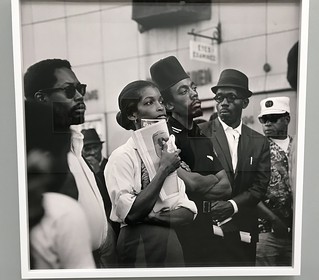
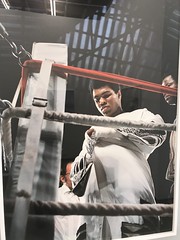
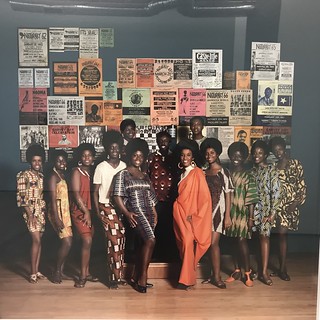


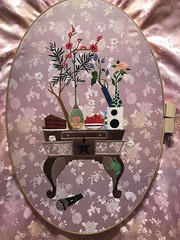
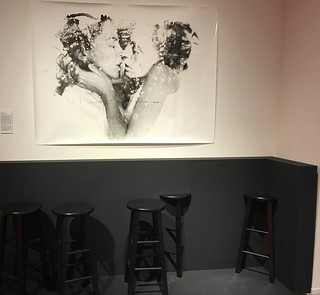


No comments:
Post a Comment